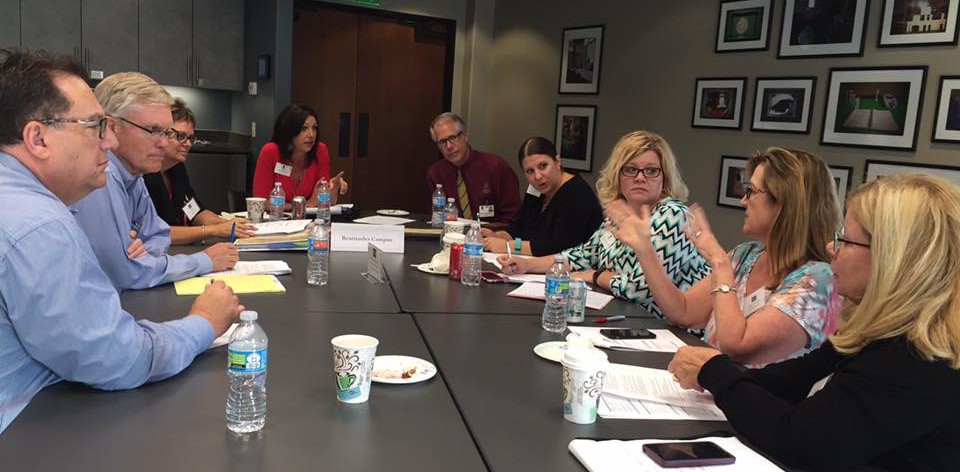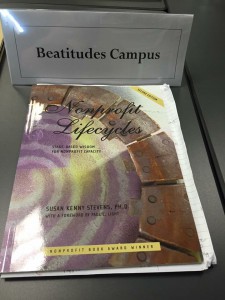One of the greatest privileges of being President and CEO at Beatitudes Campus is being able to share with you our mission in action over the past year. The work “behind the scenes” has been extraordinary, and the initiatives that we are exploring and putting into action will help position the campus not just for success today, but for years to come. Throughout this past year, the senior staff has been developing our plan, which is based on five strategic pillars that will continue to hold up the vision and promise of Beatitudes Campus.
I have taken the opportunity to present the State of the Campus to our board of directors and the Residents Council and will be speaking to several other groups; however, I want to share it with each of you so you have a better understanding of work behind the scenes of this wonderful community.
Since becoming your CEO two years ago, we have experienced many successes and milestones. We launched the business plan for Comfort Matters, our dementia education program, as well as beginning the pre-work and research of our redevelopment planning. We celebrated two deficiency-free surveys in assisted living and the health care center! We have also maintained our Center for Medicare Services 5-star Quality Rating for the health care center. Kudos! Resident satisfaction, as evidenced by the Holleran Satisfaction survey held last spring, is at an all-time high of 87.6%, which is above the Holleran Benchmark of other life plan communities (formally known as CCRCs). Most importantly, we continue to see the fruition of the purposeful living initiatives through the creation of many resident-driven groups.
We have also had a few hurdles to overcome. Due to occupancy issues in various programs, the staff dealt with two budget contingency plans, with the focus on cutting costs without losing quality. This also included the incredibly difficult decision of wage freezes and the elimination of 11 staff positions – by far the most crucible moment of my career. At that time, we also saw a spike in employee turnover. All of this weighs heavy on our community and you will see later in this article the successful steps we have taken to address this issue.
As we embark on the 52nd year of operation, there continues to be a strong focus on delivering on the promise of our mission, vision and core values of Compassion, Accountability, Respect and Excellence. The following highlights are just some of the great work that is happening campus-wide. Please know these are just some examples of the team’s work and there are many more initiatives taking place in departments, interdisciplinary teams, and resident groups across this community.
Pillar #1-Financial Sustainability: We will improve our financial performance and the effective use of our assets to guarantee financial sustainability so that we can continue to invest in our people, services, research, innovation, infrastructure, and mission expansion.
There is a significant focus on occupancy stabilization and programmatic growth while continuing to manage expenses. Department directors are doing extremely well in managing their budgets and we have invested funds and time into occupancy development. To date, I am delighted to share we are meeting budget expectations.
We welcomed Rod Bailey as our Senior Vice President of Sales and Marketing earlier this month and we will see a continuation of our radical hospitality/first impression initiative through the generous grant given by our own Beatitudes Campus Foundation. These dollars will be used for upgrades throughout the campus in and around various lobbies and common spaces.
Pillar #2-Redevelopment/Repositioning: We will focus our efforts to reposition ourselves by looking for ways to improve the marketability of our campus and enrich the community experience for existing and future residents.
We have officially kicked off our master planning in the last few months. This process consists of research, financial modeling of various options, and eventual focus groups while accomplishing two key objectives. First, we must identify the best path to feasibility for the new phase of entrance fee apartments and health care center. Second, the phase must produce enough additional borrowing capacity and strengthen the campus’ financial portfolio to complete the rehabilitation of the North and South Plaza Apartments and Plaza View Assisted Living. As always, we will keep you updated on the process as it unfolds.
Pillar #3-Employee and Board Development: We will increase our commitment to developing and engaging our employees through education and training while recruiting a knowledgeable and engaged board of directors.
Employees are the heart and soul of our mission. They are the ones who deliver quality care and services every day, and their retention and satisfaction is important. Due to the high turnover experienced over the past several years, having spiked at 49.5%, our human resources team and department directors have implemented new interview and hiring tools, transitioned to panel interviews with peers, and created onboarding practices to set new team members up for success. Departments, like maintenance and housekeeping, have produced leadership development and mentoring programs. Turnover is down to 41% with a goal of reaching 35% by the end of next year.
As a nonprofit organization we are governed by a volunteer board of directors. With the ever-changing health care and aging services arenas, the executive committee and I are focusing on governance best practices, right-sizing the board, recruiting members with certain specialties, and education of campus programs and trends in the aging services field.
Pillar #4-Programming and Amenities Enhancement: We will continually evolve our programming, amenities, and services to meet the changing needs and preference of those we serve through our commitment to person directed practice.
The vibrancy, empowerment, and just plain fun that happens among the residents is one of the most important aspects of this community. In the last year and through funding by the Campus Foundation, we saw the launch of Success Matters, a program designed to assist residents with living fully.
We have also seen a significant increase in other programs and resident-driven initiatives, like Lifelong Learners, fitness classes, and various arts programming. Did you know there are an amazing 96 resident groups, committees, clubs, and services currently on campus? This type of engagement would not be possible without the dedicated and creative life enrichment and fitness team, our highly active Residents’ Council and the volunteerism and donations by the Beatitudes Campus Auxiliary.
Pillar # 5-Home and Community Based Services: We will expand our efforts to those in need of a variety of services to the boarder community and provide support of independence to those who may never choose to live within a community such as ours.
Our home- and community-based programs, Beatitudes At Home and Beatitudes Home Health, continue to serve more clients and broaden the types of services provided. Beatitudes at Home recently launched its geriatric case management program and Beatitudes Home Health has doubled the number of seniors it serves.
It’s not just the individuals we serve through our community programs, it is organizations as well. Comfort Matters dementia training is now taking place in 13 communities across the nation with one already accredited as a Comfort Matters organization. We are delighted to share the evidence-based practice that was created within the health care center is recognized as one of the top dementia care programs internationally.
As you can see there is much going on in this beautiful campus and I hope you never forget we are one community with empowered residents and a dedicated staff. We continue to honor our past, evolve to better serve those in the present as we plan for the next 50 years.
My best,
Michelle






 At last Wednesday’s Town Hall, I had the opportunity to share some exciting news. I announced the campus has been invited to participate in a very successful two-year program offered to eight past grantees of the Virginia G. Piper Charitable Trust. The program, ATLAS, is designed to strengthen and sustain the operating capacity of Trust-identified nonprofits who play important roles in Maricopa County’s human service, civic and cultural life.
At last Wednesday’s Town Hall, I had the opportunity to share some exciting news. I announced the campus has been invited to participate in a very successful two-year program offered to eight past grantees of the Virginia G. Piper Charitable Trust. The program, ATLAS, is designed to strengthen and sustain the operating capacity of Trust-identified nonprofits who play important roles in Maricopa County’s human service, civic and cultural life. Piper Trust has a history of proactively leading and developing programs intended to further strengthen nonprofit organizations so they can serve the community’s ever growing needs. We have been blessed with two grants from Piper Trust over the years. The first in 2002 to fund our initial redevelopment work, then again in 2011 to launch a new program in our organization, Beatitudes Home Health.
Piper Trust has a history of proactively leading and developing programs intended to further strengthen nonprofit organizations so they can serve the community’s ever growing needs. We have been blessed with two grants from Piper Trust over the years. The first in 2002 to fund our initial redevelopment work, then again in 2011 to launch a new program in our organization, Beatitudes Home Health.